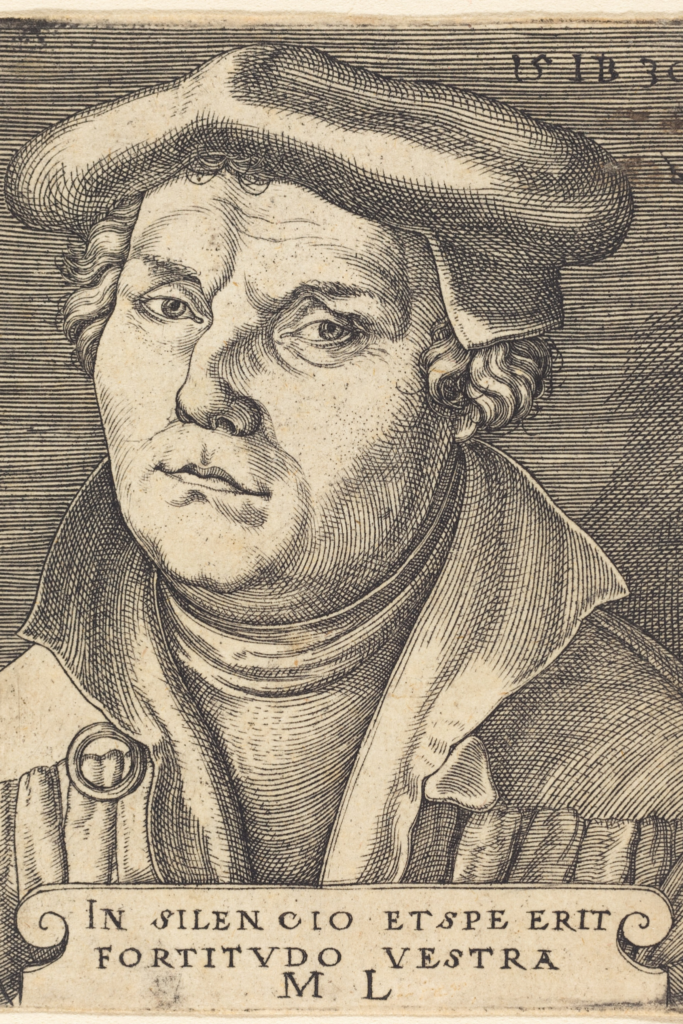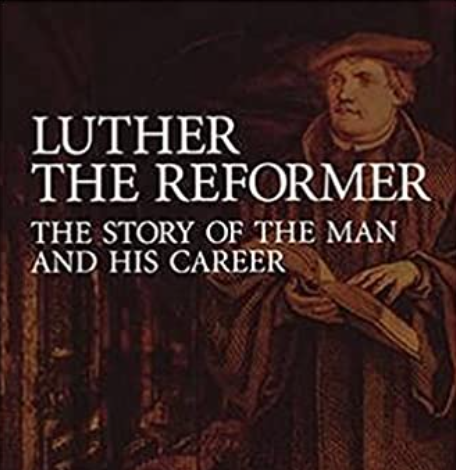“Thank, Praise, Serve, and Obey”

What more could possibly be said about the famous St. Martin Luther, the German theologian, professor, pastor, and reformer whom the Church commemorates on February 18th? This man’s story is ingrained within many of us—yet no matter how many times it has been told, his life’s journey continues to be an inspiration, beacon of hope, and topic of interest to people throughout Christendom, even 500 years after he walked the earth.
Born to a peasant family in Eisleben in 1483, Luther was the second son born to his parents. Upon his father’s early decision that he would become a lawyer, Luther was sent to school at a young age to learn grammar and rhetoric. In 1501 he began to study at the University of Erfurt. However, this trajectory changed when, in the summer of 1505, tradition holds that Luther was caught in a storm and was convinced he was going to die: in fear he cried out a prayer to St. Anne, mother of Mary, and promised that if he was saved, he would devote his life to the monastery. Although this decision meant that he abandoned his parent’s plans for him to become a lawyer, he threw himself into his work as a monk.
Over time, Luther’s theology began to evolve as he developed a nuanced critique of the medieval world around him. In 1517 he posted his famous 95 Theses to the Castle Church door in Wittenberg, and the Reformation began. What followed was a series of dramatic twists and turns that make Luther’s story one of the most iconic and interesting narratives of the Middle Ages.
Throughout the Reformation, Luther continued his reading and writing, always in conflict with the pope and those who opposed him. However, Luther always held true to his conclusions about the Christian faith, and from him came an impressive opus of work, some of which is still being made accessible to us today. Over the course of his life he translated the Scriptures from their original languages into German, wrote numerous sermons and commentaries, composed many hymns, resurrected and recreated the liturgies used within the church, and corresponded prolifically with his friends and family.
In his later years, Luther spent much of his time and energy helping the Reformation take hold throughout Germany and the other countries of Europe. His marriage to Katharina von Bora was very strong and served as an inspiration to many. Together they had six children and formed a unique home culture that would become an essential piece of Lutheranism.
Although Luther always thought he would be martyred for his bold confession, he instead died of a stroke at age 62 in Eisleben on February 18, 1546. He was buried in front of the pulpit of the Castle Church in Wittenberg.
A Brief History
St. Martin Luther has been highly celebrated within the Church on this date since his death, as his popularity and reverence only continued to grow in the years after the Reformation’s inception. Because Lutheranism spread so widely and quickly throughout Europe, with Lutheranism even becoming the state religion in countries such as those in Scandinavia, the history and customs surrounding his day are also varied. They included not only cultural homages to Luther himself but also the celebration of the German and Protestant heritage at large.

After all, Luther, as one of the most influential figures in Western history, is often thought of as the main man responsible for both sparking the Protestant Reformation and giving us the teachings and theology that we as Lutherans find and revere in the Book of Concord.
The Reformation also instigated a culture of Lutheranism that provides us with much of the basis for the liturgical living material and content upon which we reflect here at All the Household. For example, it was Luther who encouraged Lutherans to continue to commemorate the saints, not through worshiping or invoking them but instead by remembering and reflecting upon them as useful examples for our own lives of faith.
Luther also worked to preserve much of the Church’s liturgy throughout the Reformation era, encouraging Lutherans to stay consistent in their worship forms and to use them for training the uneducated and young Christians. His changes to the mass did not result in a complete elimination of catholic traditions because he advocated for Lutherans to keep what they had inherited and simply remove elements that were contrary or distracting from the Gospel.
Lastly, Luther greatly emphasized the importance of teaching and catechesis for grounding faith. For Luther the use of hymns, stories, readings, and culture in general was essential to teaching and learning the tenets of Christianity. His Small and Large Catechisms demonstrate this, used as tools to facilitate our human task to “thank, praise, serve, and obey Him.”

Collect
O God, Who didst give Blessed Martin, to Thy people as a minister of eternal salvation: grant, we beseech Thee, that we, who have had him for our teacher on earth, may with him enjoy Thine eternal glories; through Jesus Christ our Lord, liveth and reigneth with Thee and the Holy Ghost: ever one God, world without end. Amen
Lessons
Epistle
Gospel
Resources
James M. Kittleson. Luther the Reformer: The Story of the Man and His Career. Augsburg Fortress Press. 2003.
Propers found in Daily Divine Service Book: A Lutheran Daily Missal, edited by the Rev. Heath Curtis
References:
1. Weedon, William. Celebrating the Saints. Concordia Publishing House. 2016.
2. Kolb, Robert. “What Does Luther Give Us to Tell Our Children?”
3. Birkholz, Mark. [“Luther’s Reform of the Mass.”](https://lutheranreformation.org/worship/luthers-reform-mass/#:~:text=“As far as possible%2C we,the uneducated and the young.) 2017.
4. Armstrong, Dave. “Martin Luther’s Espousal of the Veneration of Saints.” 2019.
Images:
1. Martin Luther, 1530, Master IB, Germany, c. 1523/1530.
2. Martin Luther Translating the Bible, Eugene Siberdt, Belgium, 1898.
3. Martin Luther Preaching, Lucas Cranach, Germany, 1547.



